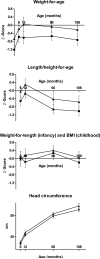Effects of heavy prenatal alcohol exposure and iron deficiency anemia on child growth and body composition through age 9 years
- PMID: 22897691
- PMCID: PMC3697011
- DOI: 10.1111/j.1530-0277.2012.01810.x
Effects of heavy prenatal alcohol exposure and iron deficiency anemia on child growth and body composition through age 9 years
Abstract
Background: Prenatal alcohol exposure has been associated with pre- and postnatal growth restriction, but little is known about the natural history of this restriction throughout childhood or the effects of prenatal alcohol on body composition. The objective of this study was to examine the effects of heavy prenatal alcohol exposure on longitudinal growth and body composition.
Methods: Eighty-five heavy drinking pregnant women (≥2 drinks/d or ≥4 drinks/occasion) and 63 abstaining and light-drinking controls (<1 drink/d, no binging) were recruited at initiation of prenatal care in an urban obstetrical clinic in Cape Town, South Africa and prospectively interviewed during pregnancy about alcohol, smoking, drug use, and demographics. Among their children, length/height, weight, and head circumference were measured at 6.5 and 12 months and at 5 and 9 years. Percent body fat (BF) was estimated at age 9 years using bioelectric impedance analysis.
Results: In multiple regression models with repeated measures (adjusted for confounders), heavy alcohol exposure was associated with reductions in weight (0.6 SD), length/height (0.5 SD), and head circumference (0.9 cm) from 6.5 months to 9 years that were largely determined at birth. These effects were exacerbated by iron deficiency in infancy but were not modified by iron deficiency or measures of food security at 5 years. An alcohol-related postnatal delay in weight gain was seen at 12 months. Effects on head circumference were greater at age 9 than at other age points. Although heavy alcohol exposure was not associated with changes in body composition, children with fetal alcohol syndrome (FAS) and partial fetal alcohol syndrome (PFAS) had lower percent BF than heavy exposed nonsyndromal and control children.
Conclusions: Heavy prenatal alcohol exposure is related to prenatal growth restriction that persists through age 9 years and an additional delay in weight gain during infancy. FAS and PFAS diagnoses are associated with leaner body composition in later childhood.
Copyright © 2012 by the Research Society on Alcoholism.
Figures
References
-
- Astley SJ, Clarren SK. Measuring the facial phenotype of individuals with prenatal alcohol exposure: correlations with brain dysfunction. Alcohol Alcohol. 2001;36:147–159. - PubMed
-
- Barker DJ. The developmental origins of adult disease. J Am Coll Nutr. 2004;23:588S–595S. - PubMed
-
- Bickel G, Nord M, Price C, Hamilton WL, Cook JT. Guide to Measuring Household Food Security. Department of Agriculture, Food and Nutrition Service; Alexandria, VA: 2000. Revised 2000.
-
- Bowman RS, Stein LI, Newton JR. Measurement and interpretation of drinking behavior. I. On measuring patterns of alcohol consumption. II. Relationships between drinking behavior and social adjustment in a sample of problem drinkers. J Stud Alcohol. 1975;36:1154–1172. - PubMed
Publication types
MeSH terms
Grants and funding
- P30 DK040561/DK/NIDDK NIH HHS/United States
- K24 HD058795/HD/NICHD NIH HHS/United States
- R01 AA09524/AA/NIAAA NIH HHS/United States
- K23 AA020516/AA/NIAAA NIH HHS/United States
- U24 AA014815/AA/NIAAA NIH HHS/United States
- R01 AA016781/AA/NIAAA NIH HHS/United States
- R01 AA009524/AA/NIAAA NIH HHS/United States
- K12 RR025757/RR/NCRR NIH HHS/United States
- U24 AA014809/AA/NIAAA NIH HHS/United States
- U01 AA014809/AA/NIAAA NIH HHS/United States
- U01 AA014790/AA/NIAAA NIH HHS/United States
- KL2 RR025757/RR/NCRR NIH HHS/United States
LinkOut - more resources
Full Text Sources
Medical
Research Materials
Miscellaneous


